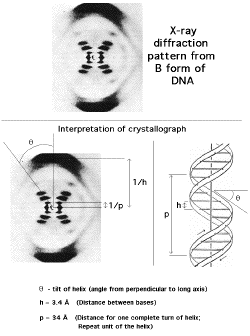
A. Those are really good questions. My understanding is that the electron clouds are the source of diffraction - and heavier nuclei, having greater electron density (like the phosphorus in DNA, see below), have greater effects than lighter nuclei. Here are some excerpts of an explanation by Max Perutz (who eventually worked out the structure of hemoglobin with X-ray diffraction and biochemistry, and won the Nobel Prize in 1962): "In diffraction you get strong intensities from where the atoms lie along repeated planes ... Mutual interference between parallel crystal planes blocks off and suppresses the diffracted beams except at certain angles; but at those angles, the reflections from the planes in the set of planes must have caused it."
Imagine the X-ray beam going through the parallel helices perpendicular to the long axis. The DNA stretched out with millions of parallel strands under appropriate conditions makes something with crystal-like characteristics -- at least enough to give a reasonable diffraction pattern.
"The helices then look to the x-rays as though the atoms are lying on repeated planes - the planes of the zigs and zags ... the result, when the rays reach the film, is a striking arrangement of short horizontal smears that step out along the diagonals from the bull's eye, in a characteristic X or maltese cross. The zigs cause one arm of the cross, the zags the other. The exact angle of the cross is caused by the angle of the zigs to the zags -- that is, by the pitch of the helix."
"The 3.4 Angstrom spot happens because the nucleotides -- in particular the heaviest thing in them, the phosphorus atoms -- repeat along the helix at that interval...The fact that in DNA the bases are stacked in the helix parallel to each other at that 3.4 Angstrom distance makes the spot more intense."